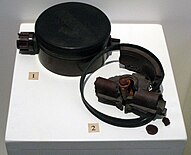PMN mine
The PMN (Russian: противопехотная мина нажимная, romanized: protivopekhotnaya mina nazhimnaya, lit. 'anti-personnel pressure mine') series of blast anti-personnel mines were designed and manufactured in the Soviet Union. They are one of the most widely used and commonly found devices during demining operations. They are sometimes nicknamed "black widow" because of their dark casings.[1]
PMN-1
The design of the PMN-1 mine dates from the late 1950s. It is particularly deadly because it contains an unusually large
These mines are palm sized and cylindrical in shape. The PMN-1 has a
The PMN-1 mine is armed by removing a steel ring-pull at the end of the horizontal fuze. When in position, the pin on the end of the ring-pull holds a
- Height: 57 mm (2.2 in)
- Diameter: 112 mm (4.4 in)
- Main charge weight: 240 g (8.5 oz) )
- Total weight: 600 g (1.3 lb)
- Fuze: MD-9 (stab-sensitive)
- Operating pressure: 5.8 kg (13 lb)
-
Two PMN-1 mines: the first example is complete, the other shows the appearance of a PMN-1 after it has detonated
-
The striker assembly from a PMN-1 showing the lead-shear arming delay. This assembly would be located under the round knurled cap on the right in the picture above
PMN-2


The PMN-2 mine casing is made from injection-molded plastic. In general, the color is leaf-green, but occasionally brown examples may be encountered. The top of the mine has a black rubber X-shaped pressure plate. The filling is an
One significant difference between the PMN-1 and PMN-2 is that the PMN-2 (a mid-1970s design) contains a more modern
The PMN-2 fuze features an arming delay of approximately 60 seconds. When the arming key is rotated and removed from the mine, the arming pin is sheared. This allows the air-bellows inside the mine to be inflated by the compression spring, which in turn lifts a “safety” bar from the path of the slide, unblocking its travel. The arming delay on a PMN-2 is significantly shorter than that of a PMN-1.[2]
- Height: 53 mm
- Diameter: 120 mm
- Main charge weight: 100 g TG-40 (TNT)
- Total weight: 420 g
- Fuze: MD-9 (stab-sensitive)
PMN-4

The PMN-4 is a delay-armed, pressure-fired blast-mine. The pressure-plate is black and the body is reddish-brown or khaki. The black rubber pressure-plate has a plastic pressure "spider" concealed underneath, shaped like flower-petals. The diameter of the mine is 95mm and the height is 46mm. The explosive charge weight is 55 grams. This comprises 52 grams of 'TG-40' (a 40/60 TNT/RDX mixture) plus a 3 gram pentolite booster. The total weight of the mine is 300 grams. PMN-4 mines contain a significant amount of metal components, so they are readily detectable with a mine detector. Details of the fuze mechanism are scarce, though given that the PMN-4 was designed during the early 1980s, it is logical to assume that the fuze is more sophisticated and/or reliable than the fuze in the PMN-2 (a mid-1970s design) to compensate for having a smaller explosive filling with significantly reduced destructive power. Similarly, the PMN-4 is almost certainly a blast resistant mine due to the design of the flower-shaped pressure "spider" under the pressure-plate.[3] Cross-sectional diagrams of the PMN-4 showing its components support the view that the PMN-4 is a more sophisticated design than the PMN-2.[4] Examples of the PMN-4 have been encountered in Ukraine and Southern Syria.[5]
- Height: 42 mm
- Diameter: 95 mm
- Main charge weight: 50 g TG-40 (TNT)
- Total weight: 300 g
- Actuation force: 5–15 kg[6]
Render-safe procedure
It is considered extremely dangerous to disarm PMN mines by removing the
-
PMN-1 type mines found in Iraq (2003)
Variants
- Type 58: Chinese copy of the PMN-1.[8]
- MM 2:
- Gyata 64: Hungarian copy of the PMN-1.[10]
- PM-79 mine: Bulgarian variant of the PMN-1.[11]
- MS-3: Has existed since at least 1973. It looks similar to the PMN-1, but has a small "blister" in the centre of the pressure-plate, incorporating a spring-loaded, pressure-release boobytrap device without being buried, for example deliberately planted inside a building or a vehicle with some form of weight on top such as a suitcase.[12]
- PMN-3: looks similar to the PMN-2, but incorporates a battery-operated tilt-switch phlegmatized RDX i.e. RDX and paraffin wax. The total weight of the PMN-3 is 600g. This mine has been encountered in Chechnya.[13]
See also
References
- OCLC 474490190.
- ^ "Archived copy" (PDF). Archived from the original (PDF) on 2011-02-18. Retrieved 2011-01-21.
{{cite web}}: CS1 maint: archived copy as title (link) - ^ "OrData - Data Details". Archived from the original on 2011-08-23. Retrieved 2011-03-23.
- ^ "Противопехотные мины армии РФ: ПМН, ПМН-2, ПМН-3, ПМН-4, ПОМЗ-2, ПОМЗ-2М, ОЗМ-72, МОН-50, ПОМ-2Р".
- ^ "Russian PMN-4 anti-personnel landmines in Syria - Armament Research Services (ARES)". October 2015.
- ^ "Инженерные боеприпасы (ПМН-4) - PMN-4.HTML".
- ^ "Инженерные боеприпасы (МЛ-7) - ml-7.HTML". Archived from the original on 2012-09-09. Retrieved 2012-09-09.
- ^ "Type 58 (AP Blast) Landmine". CAT-UXO. Retrieved 2023-02-17.
- ^ "MM-2 Landmine". CAT-UXO. Retrieved 2023-02-17.
- ^ "GYATA-64 Landmine". CAT-UXO. Retrieved 2023-02-17.
- ^ "PM-79 Landmine". CAT-UXO. Retrieved 2023-02-17.
- ^ "MS-3 Firing Device". CAT-UXO. Retrieved 2023-02-17.
- ^ "PMN-3 Landmine". CAT-UXO. Retrieved 2023-02-17.
External links
- Cross-sectional view of PMN-1 mine showing firing mechanism
- Animated cross-sectional view of a PMN-1 showing the arming and firing mechanisms in operation
- NoLandMines page on PMN
- NoLandMines page on PMN-2
- PMN-2 Dissection article (details its components and their operation) Archived 2011-02-18 at the Wayback Machine from Ambidextrous Magazine (issue 4)
- PMN-1 at ORDATA
- PMN-2 at ORDATA
- Exploded views of the PMN-1 & PMN-2 (Russian language website)
- Evaluation of a Silent Killer: the PMN Anti-Personnel Blast Mine
- Russian ML-7 pressure-release antihandling device (circa 1984) for use with PMN mines




